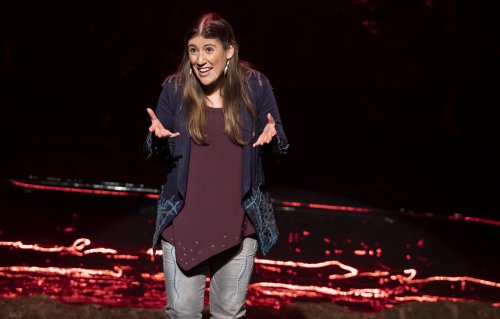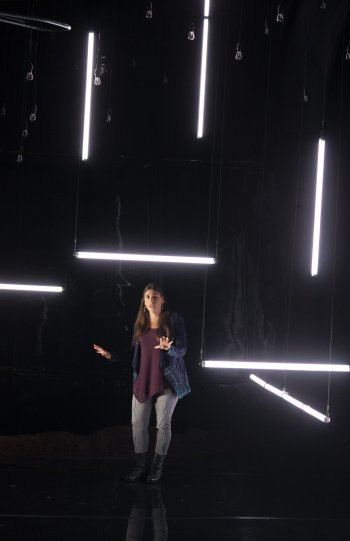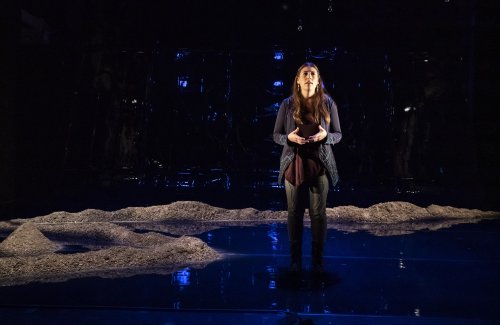Where We Belong
An autobiographical tale of the performer’s Mohegan roots and her seeking her place as she travels to London to pursue a PhD in Shakespeare.

Madeline Sayet in a scene from her “Where We Belong” at The Public Theater (Photo credit: Joan Marcus)
[avatar user=”Victor Gluck” size=”96″ align=”left”] Victor Gluck, Editor-in-Chief[/avatar]
Writer/ director/actress Madeline Sayet is an engaging performer. Directed by Mei Ann Teo, her one-woman show Where We Belong is an autobiographical tale of her Mohegan roots and her seeking her place in the world as she travels to London to pursue a PhD in Shakespeare. While much of the play contains information and stories that will come as a revelation to most New Yorkers, the play often feels like a lecture with an agenda. The most interesting parts are her own discoveries about her roots and her encounters with other people in which she plays both characters.
Sayet was always attracted to the plays of Shakespeare as she felt that he offered the words that she did not have. Most attracted to The Tempest as she saw Caliban as an indigenous person, her theater career was launched by a Native American production of this play which takes place in what was then called the New World and which was inspired by accounts of explorations to this continent. She also sees Shakespeare as anti-colonialist because of this play though her mother, the medicine woman of their tribe, could not understand why she would want to travel across the ocean to study a dead white man.

Madeline Sayet in a scene from her “Where We Belong” at The Public Theater (Photo credit: Joan Marcus)
Feeling alone and isolated in London as the sole Mohegan, at Southwark Cathedral she accidentally stumbles on the grave of one of her ancestors, the Mohegan chieftain Mahomet Weyononon, who had traveled to England in 1735 to meet with King George III to complain about the treatment of his people. Unfortunately, in the month he waited patiently for an appointment, he died from smallpox and was buried in what was then the foreign cemetery. She later comes across a copy of the sermons of Mohegan Samson Occom, the first Native writer to be published in book form in English, an ordained Presbyterian minister who also traveled to England in the 18th century to meet with the king, only to have the 12,000 pounds he raised for Native education used to found Dartmouth College for white students only.
She also dramatizes an encounter she has with a British academic who wanted to meet her at the British Museum to hear her thoughts on the Native American exhibits. To her chagrin she finds that not only does the museum not have very good attribution to its Native holdings, many of which are mislabeled, the museum owns 12,000 unburied human remains. Not only must Mohegans be returned to their native land in Connecticut, their beliefs require them to be given a ceremonial burial.

Madeline Sayet in a scene from her “Where We Belong” at The Public Theater (Photo credit: Joan Marcus)
Aside from learning the origin of her Mohegan name, Flying Bird (Jeets Bodernasha), in her honor as the last fluent speaker of the Mohegan language, much of the play is Sayet’s quandary over finding her place in two countries that have not dealt with their colonialist past. While she doesn’t accuse the audience of being part of this conspiracy, she does often sound like she is lecturing us on the problems that this causes her. Where We Belong often seems to be too long and single-minded in its investigation of her feelings about these conflicts and not entirely dramatized. Nevertheless, Where We Belong is interesting simply because much of the information will be entirely new to her listeners.
While the abstract physical setting and the lighting by Hao Bai often creates magical effects, it also takes some time to get used to its unexplained designs. The stage floor has a structure which resembles either sand dunes or a faraway mountain range. Above the set is an abstract metal sculpture which seems to mirror the stage design, along with long strings of dangling light bulbs which may represent stars. In addition are bars of lights at various angles which descend to become the exhibition cases at the British Museum. The back wall is a curved shiny Mylar plane which is lit at various times to become clouds, sky or the universe in shades of blue. Sayet’s outfit by Asa Benally is a cross between Native dress and modern sportswear. The haunting music is by Erik Schilke.
This one-woman show now at The Public Theater is a co-production with Woolly Mammoth Theatre Company in association with the Folger Shakespeare Library has been seen in many parts of the United States. It will open audiences’ eyes to the plight of Native Americans who have a conflict of identities in a modern civilization which does not give their heritage its due. On the other hand, some may feel that Where We Belong is less a play than an academic address.
Where We Belong (through November 27, 2022)
The Public Theater with Woolly Mammoth Theater Company
In association with Folger Shakespeare Company
LuEsther Hall, 425 Lafayette Street, in Manhattan
For tickets, call 212-967-7555 or visit http://www.publictheater.org
Running time: 95 minutes without an intermission






Leave a comment